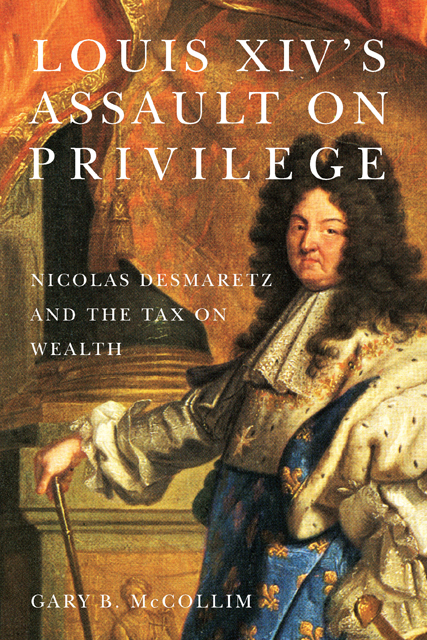Book contents
- Frontmatter
- Dedication
- Contents
- List of Illustrations
- Preface
- List of Abbreviations
- Introduction
- 1 The Fiscal System under Louis XIV
- 2 The Rise of the Administrative Monarchy
- 3 Nicolas Desmaretz and Company
- 4 Handling Ideas for Reform
- 5 The Establishment of the Dixième
- 6 After the Dixième
- Conclusion
- Appendix 1 The Conseil d’en haut, or the Council of Ministers
- Appendix 2 Members of the Royal Council of Finances under Louis XIV
- Appendix 3 Controllers General, Directors, and Intendants of Finances
- Appendix 4 Glossary of Terms
- Notes
- Bibliography
- Index
- Frontmatter
- Dedication
- Contents
- List of Illustrations
- Preface
- List of Abbreviations
- Introduction
- 1 The Fiscal System under Louis XIV
- 2 The Rise of the Administrative Monarchy
- 3 Nicolas Desmaretz and Company
- 4 Handling Ideas for Reform
- 5 The Establishment of the Dixième
- 6 After the Dixième
- Conclusion
- Appendix 1 The Conseil d’en haut, or the Council of Ministers
- Appendix 2 Members of the Royal Council of Finances under Louis XIV
- Appendix 3 Controllers General, Directors, and Intendants of Finances
- Appendix 4 Glossary of Terms
- Notes
- Bibliography
- Index
Summary
This book has explored the political and economic thinking and actions of the government of Louis XIV during the latter part of the seventeenth century and the first decades of the eighteenth century, the so-called black hole of French historiography. The government at the end of Louis XIV’s reign needs a definitive history. Until that history is explored and a definitive synthesis written, we will continue to see syntheses and popular history relying on sources such as the Mémoires of the Duke of Saint-Simon, a man who created myths about the events he was describing and indicted Louis XIV and his ministers for all sorts of crimes and misdeeds, rather than writing an impartial history of his times.
Saint-Simon was undoubtedly a talented writer whose command of the French language was so strong that he could make his readers believe that he had witnessed the events he described as they were taking place, even though Saint-Simon remained outside of les affaires until after the death of Louis XIV. Nonetheless, many modern histories continue to rely on his descriptions of people and events at the court of Louis XIV. This book has revealed many examples of Saint-Simon’s unreliability as an eyewitness to the events of his time. While his animosity toward many people, including Desmaretz, colored his description of events that he did witness, he also described events that he could not possibly have witnessed, since he did not reside at court permanently until the late 1690s. He did not begin to write his memoirs until 1738, forty years after the earliest events he could have witnessed. When he completed his masterpiece in 1748, he was describing his last days at court in 1723, events that had happened twenty-five years previously. (Here historians should perhaps ask how good is anyone’s memory of events that took place twentyfive or more years ago.) Saint-Simon was neither a witness to events at the beginning of the reign nor during the time of Colbert and Louvois, the so-called glory days of the reign.
- Type
- Chapter
- Information
- Louis XIV's Assault on PrivilegeNicolas Desmaretz and the Tax on Wealth, pp. 221 - 228Publisher: Boydell & BrewerPrint publication year: 2012

